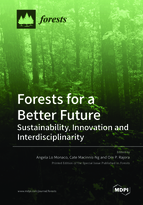Forests for a Better Future: Sustainability, Innovation and Interdisciplinarity
A special issue of Forests (ISSN 1999-4907).
Deadline for manuscript submissions: closed (10 September 2021) | Viewed by 53452
Special Issue Editors
Interests: wood characterisation; wood anatomy; wood modification; wood coating; mechanical testing; physical testing; wood properties; wood quality; tree growth; forest products; forest resource management; sustainability; wood in cultural heritage; wood in religious art
Special Issues, Collections and Topics in MDPI journals
Interests: plant ecophysiology; carbon and water cycles; forest function; global change
Interests: forest genetics, genomics and biotechnology; forest tree molecular, population, conservation and evolutionary genetics; structural, functional, population, conservation and ecological genomics; conservation and sustainable management of forest genetics resources
Special Issue Information
Dear Colleagues,
Welcome to the First International Electronic Conference on Forests (IECF2020) (https://sciforum.net/conference/IECF2020), to be held from 15–30 November 2020. We are looking forward to seeing you at our event. The Special Issue will publish selected papers from the Proceedings volume associated with our event on sciforum.net, an online platform for hosting scholarly e-conferences and discussion groups.
Through IECF2020, we aim to promote and advance the exciting and rapidly changing field of forestry and forest ecology. Topics of interest include, but are not limited to, the following:
- Forest Ecology, Management and Restoration;
- Forest Genetics, Ecophysiology and Biology;
- Forests and Urban Forest Sustainability;
- Forest Inventory, Quantitative Methods and Remote Sensing;
- Wood Science, Production Chains and Fuelwood;
- Forest Operations and Engineering;
- Fire Risks and Other Natural Hazards.
The papers that will be considered for publication are those that attract the most interest on the web or that provide innovative contributions. These papers will be subject to peer review, and are published with the aim of the rapid and wide dissemination of research results, developments, and applications. We hope this conference series will grow rapidly in the future, and become recognized as a new venue and way in which to present new developments related to the field of forests. The scientific committee cordially welcome you all, and we look forward to your contributions.
Dr. Angela Lo MonacoDr. Cate Macinnis-Ng
Prof. Dr. Om P. Rajora
Guest Editors
Manuscript Submission Information
Manuscripts should be submitted online at www.mdpi.com by registering and logging in to this website. Once you are registered, click here to go to the submission form. Manuscripts can be submitted until the deadline. All submissions that pass pre-check are peer-reviewed. Accepted papers will be published continuously in the journal (as soon as accepted) and will be listed together on the special issue website. Research articles, review articles as well as short communications are invited. For planned papers, a title and short abstract (about 100 words) can be sent to the Editorial Office for announcement on this website.
Submitted manuscripts should not have been published previously, nor be under consideration for publication elsewhere (except conference proceedings papers). All manuscripts are thoroughly refereed through a single-blind peer-review process. A guide for authors and other relevant information for submission of manuscripts is available on the Instructions for Authors page. Forests is an international peer-reviewed open access monthly journal published by MDPI.
Please visit the Instructions for Authors page before submitting a manuscript. The Article Processing Charge (APC) for publication in this open access journal is 2600 CHF (Swiss Francs). Submitted papers should be well formatted and use good English. Authors may use MDPI's English editing service prior to publication or during author revisions.








